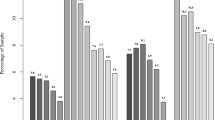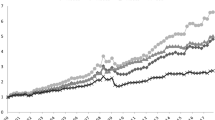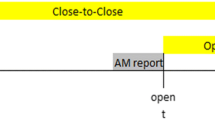Abstract
Valuation theory, investment managers, financial analysts, and textbooks advocating horizontal financial statement analysis suggest that the change in earnings growth (earnings acceleration) conveys value relevant information. We test this assertion using a large sample of U.S. firms. Results from cross-sectional short-window (around earnings announcements) and long-window (annual) returns-earnings regressions reveal a strong association between contemporaneous returns and earnings acceleration after controlling for earnings levels and changes. Moreover, earnings acceleration is useful in predicting future earnings, and financial analysts appear to use the information in earnings acceleration in addition to earnings levels and changes in revising their forecasts. Furthermore, earnings acceleration conveys information incremental to that provided by changes in analysts’ forecasts of long-term earnings growth. This study extends the empirical returns-earnings model that includes only earnings levels and changes and shows that more useful information can be extracted from reported earnings numbers than has been previously documented.
Similar content being viewed by others
Notes
AllianceBernstein L.P., which managed $99 billion in assets as of June 30, 2008, selects firms where the earnings growth rate is increasing more quickly than in the past or than expected (see The Paradox of Growth Investing, by AllianceBernstein Investments, and the Bernstein Quantitative Handbook). Ford Equity Research uses an earnings trend analysis, which measures the acceleration or deceleration of the growth of firms’ quarterly operating earnings per share after adjusting for earnings volatility, in evaluating stocks.
William O’Neil, IBD’s founder, explains the importance of earnings acceleration in several books including “24 Essential Lessons for Investment Success: Learn the Most Important Investment Techniques from the Founder of Investor’s Business Daily” (1999), “How to Make Money in Stocks—A Winning System in Good Times or Bad” (2002), and “The Successful Investor: What 80 Million People Need to Know to Invest Profitably and Avoid Big Losses” (2003).
See, for example, Oberweis Octagon at http://www.oberweisfunds.com/aboutus/octagon.asp, Mckinley Capital Management Inc.’s investment methodology at http://www.mckinleycapital.com/pages/i_trk/i_trk_mthd.html, American Century Investments’ fund description at https://www.americancentury.com/press/new_mutual_funds.jsp, the description of funds issued by Allianz Global Investors at https://www.americancentury.com/press/new_mutual_funds.jsp and http://www.allianzinvestors.com/closedEndFunds/profile/NFJ/about.jsp, and “Earnings Acceleration: The Difference between Good Stocks and Great Ones” by Kevin Matras at http://www.zacks.com. Finally, books that discuss earnings acceleration include Vega (1994), Sethna (1997), Fabozzi (1998), Mintz et al. (1999), Navarro (2003), and Bruner and Perella (2004), among others.
For example, a long literature examines the ability of earnings growth to explain contemporaneous stock returns (e.g., Kothari 2001), the equity premium (e.g., Fama and French 2002), and the cross-sectional distribution of the cost of equity capital (e.g., Fama and French 1997), as well as the relation between earnings growth and the price-to-earnings ratio (e.g., Penman 1996), the extent to which earnings growth can explain the superior performance of value or glamour stocks (e.g., Fama and French 1995), and whether earnings growth can be predicted (e.g., Chan et al. 2003).
A related stream of research examines reactions to strings of earnings increases or to a break in these strings (see, for example, Barth et al. 1999; Chan et al. 2004; Ghosh et al. 2005; Myers et al. 2007). However, these studies do not consider all possible patterns of earnings growth and do not incorporate the magnitude of the change in earnings growth into their analyses.
The Ohlson and Juettner-Nauroth model in (1) becomes equivalent to the Gordon growth model when d t+1 = E t+1 (i.e., when the dividend payout is 100%). Thus, the Ohlson and Juettner-Nauroth model is less restrictive than the Gordon growth model. In addition, it satisfies the Modigliani-Miller dividend irrelevance property.
Note that the coefficient 1/γ β 2 on (∆E t+2 − ∆E t+1) is an increasing function of γ. This makes economic sense because it indicates that the higher the rate of growth, the more highly valued is earnings acceleration (∆E t+2 − ∆E t+1).
However, in one of our tests below, we also examine whether current earnings acceleration is informative in the presence of analysts’ forecasts of the long-term earnings growth rate.
However, our main conclusions are robust to the exclusion of BM.
Specifically, the forecast revision variable is the mean earnings per share (EPS) forecast for year t + 1 available immediately after the year t earnings announcement minus the mean EPS forecast for year t + 1 available immediately after the year t − 1 earnings announcement, scaled by the absolute value of the latter. (Here, “immediately after” refers to the first consensus analyst forecast available after an earnings announcement. This is usually within one to two weeks of the earnings announcement.) We measure the forecast revision over this relatively long window because this is the window we use in our annual returns regressions. Thus, we can compare how analysts use information in earnings acceleration with how investors use information in earnings acceleration. We also construct an alternative forecast revision variable that equals the difference in the mean 1-year-ahead EPS forecast made immediately before and immediately after the year t earnings announcement. Results (not reported) are similar to those reported in Table 5.
Our results are robust to alternative cutoff points such as share prices of less than $1 or $3.
Operating income after depreciation is also used in prior non-earnings growth-related studies (e.g., Sloan 1996).
See Biddle et al. (1995) for a detailed discussion of relative versus incremental information content.
Of the three control variables, BM and lagged book value are consistently significant in all three columns. The change in current dividends is not significant in any of the short-window regressions.
Of the three control variables, only BM is consistently significant in the long-window regressions.
Specifically, we calculate the yearly difference between EA coefficients and use the Fama-Macbeth method to calculate the means, standard deviations, and t-statistics for the comparisons reported in panel C.
To further establish the relevance of earnings acceleration in explaining stock returns, we examine the extent to which earnings acceleration contributes to the findings regarding the valuation of earnings strings documented in prior studies. Barth et al. (1999) and Myers et al. (2007) find that returns are higher for firms with increasing earnings than for other firms and that incremental returns fall when the earnings strings are broken. Barth et al. (1999) suggest that earnings patterns capture value-relevant information because they capture growth over time, whereas other variables in their model capture growth at a particular point in time. Consistent with Barth et al. (1999), we find that our EA1 partition (which captures increasing growth) obtains a large coefficient in all six earnings acceleration partitions. In addition, we add the earnings acceleration terms to the returns model from Barth et al. (1999) and find that the earnings acceleration terms are significant after controlling for the string of earnings increases.
Note that the opposite signs on the ∆E t coefficients in the contemporaneous returns and earnings prediction models do not imply an inconsistency. The negative coefficient on ∆E t in the earnings prediction model captures the mean reversion of earnings (Fama and French 2000), while the positive coefficient on ∆E t in the contemporaneous returns model is consistent with valuation theory (Ohlson 1995) and with empirical evidence indicating that earnings changes are positively associated with returns (Kothari 2001).
Both the lagged change in book value and BM are highly significant in all earnings prediction regressions. However, the change in current dividends is not.
We also ran the long-window returns and earnings prediction tests on the smaller sample used in the short-window returns tests (so that the observations are constant across both tests) and we ran all of the above tests for the 1,000 largest firms in our sample (to investigate whether smaller firms are driving the results). Both sets of analyses yield results that are qualitatively identical to those reported.
All three control variables are significant in all models, suggesting that analysts use them to revise their forecasts.
Untabulated results from re-estimating model (1b) using the analysts’ forecast revisions sample very closely replicate those from the longer period in Table 3. In addition, the explanatory power is almost equal (adjusted R 2 = 25.5% for the longer period and 26.7% for the shorter period). Therefore, our contemporaneous returns results are not sensitive to the estimation period.
We also used an alternative forward-looking earnings acceleration measure defined as the expected change in future earnings growth measured by analysts’ 1-year-ahead and 2-year-ahead annual EPS forecasts made in the current year. The results are similar to those in Table 6.
For example, ∆E t−1 is significant but the incremental adjusted R 2 (of 0.51%) is much lower than that for earnings acceleration.
For example, Jegadeesh and Livnat (2006) find that revenue surprises convey information about future earnings growth beyond that in contemporaneous earnings surprises. They also find that short-window returns are associated with both earnings surprises and revenue surprises, and that analysts do not incorporate all of the information in revenue surprises when they revise their forecasts of future earnings.
We use E t in front of a squared bracket to indicate the expectation at time t.
We drop the expectation operator E t to make the algebra more tractable.
References
Aboody, D., Barth, M. E., & Kasznik, R. (2004). SFAS No. 123 stock-based compensation expense and equity market values. The Accounting Review, 79(2), 251–275.
Barth, M. E., Elliott, J. A., & Finn, M. W. (1999). Market rewards associated with patterns of increasing earnings. Journal of Accounting Research, 37(2), 387–413.
Biddle, G. C., Seow, G. S., & Siegel, A. F. (1995). Relative versus incremental information content. Contemporary Accounting Research, 12(1), 1–23.
Bradshaw, M. T., Richardson, S. A., & Sloan, R. G. (2001). Do analysts and auditors use information in accruals? Journal of Accounting Research, 39(1), 45–74.
Bruner, R. F., & Perella, J. R. (2004). Applied mergers and acquisitions. Hoboken, NJ: Wiley.
Chan, W. S., Frankel, R., & Kothari, S. P. (2004). Testing behavioral finance theories using trends and consistency in financial performance. Journal of Accounting and Economics, 38(1–3), 3–50.
Chan, L. K. C., Karceski, J., & Lakonishok, J. (2003). The level and persistence of growth rates. The Journal of Finance, 58(2), 643–684.
Chen, P., & Zhang, G. C. (2007). How do accounting variables explain stock price movements? Theory and evidence. Journal of Accounting and Economics, 43(2/3), 219–244.
Copeland, T., Dolgoff, A., & Moel, A. (2004). The role of expectations in explaining the cross- section of stock returns. Review of Accounting Studies, 9(2/3), 149–188.
Daniel, K., & Titman, S. (2006). Market reactions to tangible and intangible information. The Journal of Finance, 61(4), 1605–1643.
Easton, P. D., & Harris, T. S. (1991). Earnings as an explanatory variable for returns. Journal of Accounting Research, 19(1), 19–36.
Fabozzi, F. J. (1998). Handbook of Portfolio Management. Hoboken, NJ: Wiley.
Fama, E. F., & French, K. R. (1995). Size and book-to-market factors in earnings and returns. The Journal of Finance, 50(1), 131–155.
Fama, E. F., & French, K. R. (1997). Industry costs of equity. Journal of Financial Economics, 43(2), 153–193.
Fama, E. F., & French, K. R. (2000). Forecasting profitability and earnings. The Journal of Business, 73(2), 161–175.
Fama, E. F., & French, K. R. (2002). The equity premium. The Journal of Finance, 57(2), 637–659.
Fama, E. F., & Macbeth, J. (1973). Risk, return and equilibrium: Empirical tests. Journal of Political Economy, 81(3), 607–636.
Ghosh, A., Gu, Z., & Jain, P. C. (2005). Sustained earnings and revenue growth, earnings quality, and earnings response coefficients. Review of Accounting Studies, 10, 33–57.
Gordon, M. G. (1959). Dividends, earnings, and stock prices. Review of Economics and Statistics, 41(2), 99–105.
Hayn, C. (1995). The information content of losses. Journal of Accounting and Economics, 20(2), 125–154.
Jegadeesh, N., & Livnat, J. (2006). Revenue surprises and stock returns. Journal of Accounting and Economics, 41, 147–171.
Kothari, S. P. (2001). Capital markets research in accounting. Journal of Accounting and Economics, 31(1–3), 105–231.
Lev, B. (1989). On the usefulness of earnings and earnings research: Lessons and directions from two decades of empirical research. Journal of Accounting Research, 27(Supplement), 153–192.
Lundholm, R. J., & Sloan, R. (2006). Equity valuation and analysis. Hill/Irwin: McGraw.
Malkiel, B. G., & Cragg, J. G. (1970). Expectations and the structure of share prices. American Economic Review, 60(4), 601–617.
Mintz, S. L., Dakin, D., & Willison, T. (1999). Beyond wall street: The art of investing. Hoboken, NJ: Wiley.
Myers, J. N., Myers, L. A., & Skinner, D. J. (2007). Earnings momentum and earnings management. Journal of Accounting, Auditing and Finance, 22(2), 249–284.
Navarro, P. (2003). When the market moves, will you be ready? New York: McGraw-Hill.
Nissim, D., & Ziv, A. (2001). Dividend changes and future profitability. The Journal of Finance, 56(6), 2111–2133.
Ohlson, J. A. (1995). Earnings, book values, and dividends in equity valuation. Contemporary Accounting Research, 11(2), 661–687.
Ohlson, J. A., & Gao, Z. (2006). Earnings, earnings growth and value. Foundations and Trends in Accounting, 1(1), 1–70.
Ohlson, J. A., & Juettner-Nauroth, B. E. (2005). Expected EPS and EPS growth as determinants of value. Review of Accounting Studies, 10(2–3), 349–365.
Ozair, M. (2004). Essays on growth in expected earnings, returns models and equity valuation. PhD Dissertation, New York University.
Penman, S. H. (1996). The articulation of price-earnings ratios and market-to-book ratios and the evaluation of growth. Journal of Accounting Research, 34(2), 235–259.
Penman, S. H. (2010). Financial statement analysis and security valuation (4th ed.). New York: McGraw-Hill.
Richardson, G., & Tinaikar, S. (2004). Accounting-based valuation models—What have we learnt? Accounting and Finance, 44, 223–255.
Sethna, D. H. (1997). Investing smart: How to pick winning stocks with investor’s business daily. New York: McGraw-Hill.
Sloan, R. G. (1996). Do stock prices fully reflect information in accruals and cash flows about future earnings? The Accounting Review, 71(3), 289–316.
Stickney, C. P., Brown, P. R., & Wahlen, J. M. (2007). Financial reporting, financial statement analysis, and valuation, a strategic perspective. Mason: Thomson South-Western.
Vega, T. (1994). Profiting from chaos: Using chaos theory for market timing, stock selection, and option valuation. New York: McGraw-Hill.
Vuolteenaho, T. (2002). What drives firm-level stock returns? The Journal of Finance, 57(1), 233–264.
Acknowledgments
We thank Louis Chan, Vicki Dickinson, Dain Donelson, Rajib Doogar, Mike Drake, Peter Easton, Zhan Gao, James Myers, James Ohlson (the editor), Stephen Penman, Joseph Piotroski, Senyo Tse, the anonymous reviewers, and workshop participants at the 2009 AAA meetings, the Accounting and Finance Research Workshop organized by the Chinese University of Hong Kong in collaboration with Tsinghua Univerisity, the ARNN Accounting Symposium at the Catholic University of Leuven, the Athens University of Economics and Business, Baruch College, McGill University, the University of Alberta, and the University of Florida for helpful comments and suggestions. Linda Myers gratefully acknowledges financial support from the Garrison/Wilson Chair at the University of Arkansas.
Author information
Authors and Affiliations
Corresponding author
Appendix
Appendix
Ohlson and Gao (2006, p. 54) present the following price model:
where p, b, and E a are price, book value of equity, and abnormal earnings, respectively, and \( \beta_{1} = \frac{1}{r},\beta_{2} = {\frac{R}{r(R - \gamma )}} \), \( \beta_{3} = \frac{1}{r} \) and r is cost of equity capital; R = 1 + r; and γ = growth in v 1t . That is, v 1t+1 = γv 1t . Ohlson and Gao (2006, p. 53) indicate that given any realization (\( E_{t}^{a} ,v_{1t} ,v_{2t} \)), it can be shown that \( E_{t} [\Updelta \tilde{E}_{\tau + 1}^{a} ] = \gamma E_{t} [\Updelta \tilde{E}_{\tau }^{a} ] \) for τ ≥ t + 2, where E t is the expectation operator.Footnote 26 That is, γ reflects the linear evolution of the change in future expected abnormal earnings.
According to the following equation on p. 53:
v 1t can be written as
Replacing \( \tilde{v}_{1t} \) in (5) with (7) yields
and
Taking the difference of these two equations and applying the clean surplus relation yieldsFootnote 27
Theory predicts positive signs on E t , ΔE t , (ΔE t+2 − ΔE t+1), and Δd t+1 and negative signs on ΔE t+1 and Δb t−1. The negative signs on ΔE t+1 and Δb t−1 are due to residual income disaggregation. The change in future earnings growth, ∆E t+2 − ∆E t+1, enters linearly into the valuation equation, while the long-term future growth rate, γ, enters nonlinearly through the valuation parameters, β s . The level of earnings, E t , assumes a valuation coefficient of 1 as it reflects the dollar-for-dollar valuation of book value of equity. The change in earnings, ΔE t , assumes a valuation coefficient of β 1 = 1/r, indicating the capitalization of the growth in earnings. The valuation coefficient on future earnings acceleration, ΔE t+2 − ΔE t+1, is positive since both β 2 and γ are positive. In addition, the derivative of 1/γ β 2 with respect to γ is positive, indicating that earnings acceleration is more highly valued when the growth rate is higher. This satisfies economic intuition. The same is true for the valuation coefficient on the change in dividends, Δd t+1.
Rights and permissions
About this article
Cite this article
Cao, Y., Myers, L.A. & Sougiannis, T. Does earnings acceleration convey information?. Rev Account Stud 16, 812–842 (2011). https://doi.org/10.1007/s11142-011-9150-y
Published:
Issue Date:
DOI: https://doi.org/10.1007/s11142-011-9150-y




